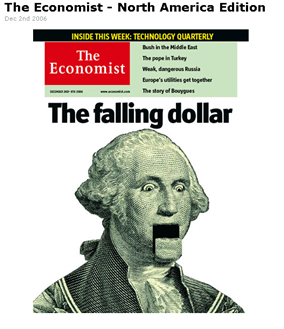Mon 11 Dec 2006
It seems that the financial news lately has been full of stories like this (via the FT):
Oil producers shun dollar – Oil producing countries have reduced their exposure to the dollar to the lowest level in two years and shifted oil income into euros, yen and sterling, according to new data from the Bank for International Settlements.
The cover of The Economist last week even taunted a falling dollar:
Now, the dollar has fallen quite a bit in the last few weeks, but let’s all try to remember the last time that the Economist had a cover lamenting the weakness in the US Dollar? I’ll give you a hint… it was in December 2004:
In case you don’t remember what happened to the dollar after December 2004, here is a quick 3 year chart of the dollar…
You’ll notice that the lowest point over the last 3 years coincided with the publication of the Economist cover lamenting the falling US Dollar in December 2004. I think missed the bottom by a whopping two or three weeks.
Now, that’s not to say that the appearance of a magazine cover causes macro-economic trends — why, that would be silly. In reality though, magazines publish stories that are popular, those ideas that will sell the most copies of their magazine. Unfortunately, popular trends tend to be near their ends — once the majority is on a trend, there are few buyers (or sellers) left to push the trend further in the current direction.
What are the reasons that the US Dollar rebounded in 2004 besides being an overly popular trade? For one, corporate inflows. Corporations based in the US repatriate funds from abroad at the beginning of the year to pay income taxes in the US. The US is the home to many global corporations, and the impact should not be underestimated.
Besides the fundamental case for the dollar, there are plenty of complaints… The “pending” collapse of the Social Security System, the mounting obligations of the PBGC, the increasing trade deficit, the constant printing press mascarading as a Federal Reserve… Unfortunately, all the other major currencies have the same ills. Europe and Japan exceed the US in their demographic crises.
Do I count myself as a Dollar Bull? Hardly… I’m more of a Gold Bull than a dollar bull. But that doesn’t mean that I believe the dollar is doomed — at least not compared to other fiat currencies (the Euro, Yen, etc.). I think the bearishness of the Economist and most other media articles overstate the bearish case, and the dollar is not as not as doomed as most believe…
What would make me change my mind? Continued weakness lasting well past February/March of next year, and/or a breakdown below 80 on the USD index (the low in 2004 was at 80.39).
What do you think?



December 12th, 2006 at 8:47 am
Since it’s unlikely for the dollar to remain flat, would the best play be an option straddle to profit from a significant move in either direction? I’m with you though–I’m thinking we’re in for a stronger dollar 6 months hence thanks to the overwhelming sentiment that’s come about mainly because of the recent precipitous drop.
December 12th, 2006 at 5:59 pm
Why do you believe it’s unlikely for the dollar to remain flat or remain in a trading range? (I’m challenging your thought process, not necessarily disagreeing with your point.)
An option straddle is good when you expect volatility, but you have to cover the cost of both legs… I don’t know how expensive currency options are, but time decay will penalize both sides of a straddle.
If I wanted to trade dollar action, I could open a forex account. I believe a futures account would be required for options on currencies, and the nominal amounts are huge in comparison to stocks — another hurdle to your option straddle idea.
Outside of forex, I could bet on a rising dollar with the Rydex Rising Dollar Fund (RDPIX). If I were to bet against it, I might use a currency ETF (FXB, FXE, FXA, FXM, though probably not FXC).
DBV (the currency harvest/carry trade ETF) should also benefit from a rising dollar since one of it’s long positions is in the USD. In theory DBV would also pay the interest rate spread while you waited for a rebound.
Gold should also do well if the dollar continues to fall, though I honestly expect it to do well even if the dollar is rising. This happened in 2005 — the USD went from 80 to 92 (a 15% gain) while gold went from 400 to 525 (a 30% gain).